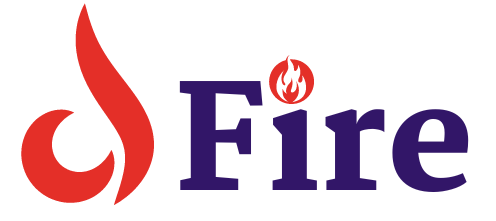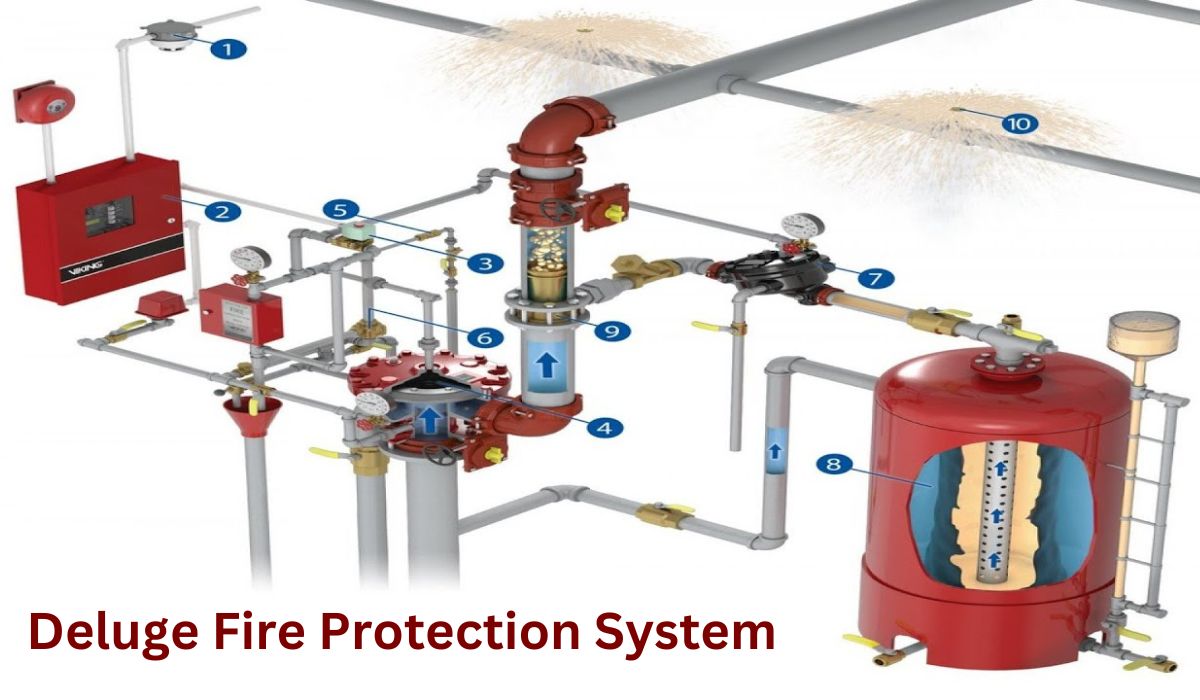A Deluge System is a fire protection system that delivers a large volume of water over a wide area. It uses open nozzles or sprinklers.
A Deluge System is essential in high-hazard environments where rapid fire suppression is crucial. It protects areas like chemical storage, power plants, and aircraft hangars by flooding them with water. The system activates through a detection mechanism, releasing water from all nozzles simultaneously.
This immediate response helps contain fires quickly, minimizing damage and enhancing safety. Unlike traditional sprinklers, Deluge Systems do not have individual heat sensors. They rely on external detectors to trigger the water flow. Ensuring proper installation and maintenance can significantly boost their effectiveness in critical situations.
Introduction To Deluge Systems
A Deluge System is a type of fire protection system. It is designed to deliver a large volume of water. This system is crucial in high-risk environments. It helps to control and extinguish fires quickly.
Purpose And Importance
The primary purpose of a Deluge System is to protect areas with high fire hazards. These systems are essential in areas with flammable liquids. They are also used in chemical storage facilities. The importance of Deluge Systems cannot be overstated. They provide rapid response to fire outbreaks. This minimizes damage and saves lives.
Key Components
A Deluge System consists of several key components. Each component plays a vital role in the system’s functionality.
| Component | Function |
|---|---|
| Deluge Valve | Controls the release of water |
| Sprinkler Heads | Distribute water over a large area |
| Water Supply | Provides the necessary water volume |
| Detection System | Detects fire and activates the system |
Understanding these components is crucial. It ensures the system operates effectively. Always ensure regular maintenance and checks.

Credit: www.vfpfire.com
How Deluge Systems Work
A Deluge System is a fire protection system. It releases a large volume of water quickly. It is used in areas with high fire risk. This section explains how Deluge Systems work step by step.
Activation Mechanism
The Deluge System has an activation mechanism. Sensors detect heat or smoke. These sensors send a signal to the valve. The valve then opens. This allows water to flow into the pipes.
Water Discharge Process
Once the valve opens, water fills the pipes. The pipes are connected to open nozzles. Water sprays out from all nozzles. This creates a curtain of water. The water helps to extinguish the fire quickly.
| Component | Function |
|---|---|
| Sensors | Detect heat or smoke |
| Valve | Opens to allow water flow |
| Pipes | Carry water to the nozzles |
| Nozzles | Spray water to extinguish fire |
- Sensors: Detect fire conditions.
- Valve: Controls water flow.
- Pipes: Deliver water to the fire.
- Nozzles: Distribute water over the fire area.
Types Of Deluge Systems
Deluge systems are vital for fire protection in many facilities. These systems have different types based on their specific applications. Below, we explore the main types of deluge systems: Water-Based Systems and Foam-Based Systems.
Water-based Systems
Water-based deluge systems use water to extinguish fires. They are common in many industries. These systems have several benefits:
- Immediate Activation: Water is released quickly to stop fires.
- Large Coverage: They cover large areas effectively.
- Easy Maintenance: These systems are simple to maintain.
Water-based systems include various types:
| Type | Description |
|---|---|
| Sprinkler Systems | Sprays water over a designated area. |
| Hydrant Systems | Provides water access for firefighting. |
Foam-based Systems
Foam-based deluge systems use foam to put out fires. These systems are ideal for flammable liquids. They offer several advantages:
- Effective Suppression: Foam smothers the fire and cuts oxygen.
- Reduced Water Damage: Less water is used, reducing damage.
- Versatile Use: Suitable for various fire types.
Foam-based systems have different types:
- Low-Expansion Foam: Covers large areas with thick foam.
- Medium-Expansion Foam: Suitable for confined spaces.
- High-Expansion Foam: Ideal for large, open areas.
Applications Of Deluge Systems
Deluge systems play a vital role in fire protection. They are designed to tackle high-hazard areas where rapid fire spread is a concern. These systems are versatile and can be used in a variety of environments. Below, we explore two primary applications of deluge systems.
Industrial Settings
Industrial settings often have a high fire risk due to the nature of their operations. Deluge systems are crucial in these environments to protect both personnel and equipment.
- Oil and Gas Facilities: These facilities handle flammable liquids and gases. Deluge systems can quickly extinguish fires, minimizing damage.
- Power Plants: Electrical equipment can easily catch fire. Deluge systems provide rapid response, preventing potential explosions.
- Manufacturing Plants: Factories dealing with chemicals or heavy machinery benefit from deluge systems. They ensure fires are controlled swiftly.
In these settings, deluge systems are integrated with alarm and detection systems. This integration ensures immediate activation during fire emergencies.
Commercial Buildings
Commercial buildings also benefit from deluge systems. They provide a robust fire protection solution for various high-risk areas within these structures.
- Warehouses: These spaces store large quantities of goods. Deluge systems protect inventory and reduce fire spread.
- Shopping Malls: Malls have large crowds. Deluge systems ensure quick fire suppression, enhancing safety for visitors.
- Parking Garages: Vehicles can be a fire hazard. Deluge systems help in controlling fires that might start in these areas.
Commercial buildings often have complex layouts. Deluge systems are designed to cover extensive areas, providing effective fire protection.
In summary, deluge systems are vital in both industrial and commercial settings. Their ability to rapidly control fires makes them indispensable in high-risk environments.
Installation Guidelines
Installing a deluge system requires careful planning and precise execution. Following these guidelines ensures the system operates effectively and safely.
Site Assessment
Before installing a deluge system, conduct a thorough site assessment. This involves evaluating the specific risks and hazards present in the location.
- Identify potential fire sources.
- Determine the type of materials present.
- Measure the area to be protected.
Consider the local climate and environmental factors. These can impact the system’s performance.
System Design
The system design must align with the site’s specific needs. This ensures maximum protection and efficiency.
- Calculate water supply requirements.
- Select appropriate nozzles and spray patterns.
- Design the piping layout for optimal coverage.
Ensure the control valves are easily accessible. This helps in quick activation during an emergency.
| Component | Specification |
|---|---|
| Piping | Corrosion-resistant materials |
| Nozzles | High-flow capacity |
| Control Valves | Manual and automatic operation |
Regular maintenance checks are essential. This ensures the deluge system remains in optimal condition.

Credit: firesystems.net
Maintenance And Testing
Maintenance and testing are vital for the effective operation of a deluge system. Regular checks ensure it works perfectly in emergencies. Proper maintenance enhances the system’s lifespan and reliability.
Routine Inspections
Routine inspections are essential for identifying potential issues. Regular checks help in keeping the system in top condition. The following tasks should be included in routine inspections:
- Check for any visible damage to system components.
- Ensure valves are in the correct position.
- Inspect nozzles for blockages or damage.
- Verify that the water supply is unobstructed.
- Examine electrical and alarm systems for functionality.
Performance Testing
Performance testing ensures the deluge system activates properly during an emergency. This type of testing involves several steps to verify full functionality:
- Conduct a full system discharge test to ensure water flow.
- Check the response time of the system.
- Verify the operation of manual and automatic activation mechanisms.
- Test the alarm and notification systems.
- Record and analyze test results for any discrepancies.
Regular maintenance and testing are key to a reliable deluge system. Always follow manufacturer guidelines and local regulations for optimal performance.
Advantages Of Deluge Systems
The Deluge System offers numerous benefits that enhance fire protection. These systems are particularly effective in high-hazard areas. Below, we delve into some of the key advantages of these systems.
Enhanced Safety
One major advantage of Deluge Systems is enhanced safety. These systems can cover large areas. They provide a rapid and thorough response to fires. This reduces the risk of fire spread. Furthermore, they cool down surrounding structures. This helps to prevent additional damage.
Deluge systems can also be integrated with smoke detection systems. This ensures immediate activation. As a result, there is reduced risk for personnel and property. This also enhances the overall safety of the environment.
Rapid Response
Deluge systems offer a rapid response to fire outbreaks. These systems release large volumes of water quickly. This helps to suppress fires before they escalate. A quick response is crucial in high-risk areas.
These systems are designed to activate immediately. This means there is no delay in the firefighting efforts. Rapid response can save lives and reduce property damage significantly.
| Advantages | Description |
|---|---|
| Enhanced Safety | Provides rapid and thorough coverage, reducing fire spread and damage. |
| Rapid Response | Activates immediately, releasing large volumes of water quickly. |

Challenges And Solutions
The deluge system is a critical fire protection mechanism. But it presents several challenges. Understanding these challenges and solutions helps maintain system efficiency.
Common Issues
Many issues can arise in a deluge system. Below are some common ones:
- Clogged Pipes: Debris can block pipes, hindering water flow.
- Corrosion: Rust weakens pipes, causing leaks.
- Faulty Valves: Malfunctioning valves can prevent water release.
- Electrical Failures: Power issues affect system activation.
- Improper Installation: Incorrect setup leads to inefficiency.
Troubleshooting Tips
Addressing these issues requires effective troubleshooting. Here are some tips:
- Regular Inspections: Inspect pipes and valves frequently for blockages and corrosion.
- Test Electrical Components: Ensure all electrical parts are working properly.
- Follow Installation Guidelines: Adhere to manufacturer instructions during setup.
- Replace Damaged Parts: Swap out faulty valves and corroded pipes promptly.
- Keep System Clean: Regularly clean the system to prevent debris buildup.
Additionally, having a qualified technician perform maintenance checks can prevent many issues. Implementing these solutions ensures the deluge system functions effectively.
Frequently Asked Questions
What Is A Deluge System Used For?
A deluge system is used for rapid fire suppression in high-hazard areas. It releases water through open nozzles.
What Is The Difference Between A Sprinkler System And A Deluge System?
A sprinkler system activates automatically when heat from a fire is detected. A deluge system releases water through all nozzles simultaneously.
What Is The DifferandAnd a Deluge System?
A wet system always has water in the pipes, ready to discharge. A deluge system has empty pipes and uses open nozzles, flooding the area when activated.
What Is the Role Of Deluge Network?
A deluge network rapidly deploys large volumes of water to suppress extensive fires. It ensures quick and effective fire control.
Conclusion
Understanding the deluge system is crucial for effective fire safety. This system offers rapid response and widespread water coverage. Implementing a deluge system can significantly minimize fire damage. Stay informed and prioritize safety measures. Always consult with professionals to ensure proper installation and maintenance.
Your safety depends on it.
“Name
I’m Abdus Sobur, a highly skilled and professional Fire Safety Officer with a passion for safeguarding lives and property. Over the course of my career, I’ve conducted numerous successful fire safety audits, earning a reputation for excellence in ensuring public safety.
In addition to my role as a Fire Safety Officer, I’m also dedicated to raising awareness about the importance of fire safety. Through my blog, I share insights into the functions of different fire safety equipment, aiming to empower individuals with the knowledge they need to protect themselves and their communities.
I’m driven by a deep commitment to promoting fire safety awareness and preventing fire-related incidents.

